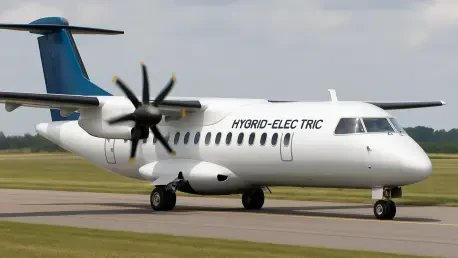Imagine a world where air travel doesn’t require long drives to distant airports, where small communities are just a short flight away from major hubs, and where sustainability is at the core of every journey. This vision is becoming a reality as hybrid-electric aviation gains traction, with companies like Electra.aero leading the charge. Based in Manassas, Virginia, Electra is redefining regional connectivity with innovative aircraft designs and strategic expansions. This market analysis delves into the trends, data, and projections surrounding Electra’s role in transforming short-haul travel, highlighting why this sector is poised for significant growth.
The importance of this analysis lies in the urgent need to address both environmental challenges and accessibility gaps in aviation. With the industry under pressure to reduce carbon emissions—aviation accounts for a notable portion of global greenhouse gases—hybrid-electric solutions offer a promising path forward. Moreover, the demand for convenient regional travel continues to rise, especially in underserved areas. This examination aims to unpack how Electra’s developments align with these broader market dynamics, providing insights into the potential reshaping of air travel infrastructure.
Understanding Electra’s position requires a look at the evolving landscape of sustainable aviation. The push for greener technologies has accelerated in recent years, driven by regulatory mandates and consumer expectations. As a key player, Electra is not only innovating with its EL-9 Ultra Short hybrid-electric aircraft but also scaling operations to meet growing interest. This analysis will explore the company’s technological edge, market demand, and the broader implications for regional aviation over the coming years.
Diving Deep into Market Dynamics and Forecasts
Hybrid-Electric Aviation: A Growing Sector
The aviation market is witnessing a pivotal shift toward hybrid-electric technologies, spurred by the dual imperatives of sustainability and efficiency. Traditional regional aircraft, reliant on long runways and fossil fuels, are increasingly seen as outdated in a world prioritizing decarbonization. According to industry estimates, the sustainable aviation sector could see investments exceeding billions in the next decade, with hybrid-electric designs projected to capture a significant share of short-haul routes by 2035. Electra.aero stands at the forefront of this trend, leveraging advancements in battery systems and aerodynamics to offer viable alternatives.
Electra’s focus on Ultra Short Takeoff and Landing (Ultra STOL) technology differentiates it within this competitive space. The ability of its EL-9 aircraft to operate in spaces as small as 150 feet opens up thousands of potential new routes, from small airports to unconventional landing sites. This capability aligns with market needs for greater accessibility, particularly in regions lacking major infrastructure. While challenges like battery range limitations persist, ongoing innovations suggest that such hurdles will diminish, further boosting the adoption of hybrid solutions.
A critical factor driving this market is government support through incentives and regulatory frameworks aimed at reducing emissions. Policies encouraging green technology adoption are creating a favorable environment for companies like Electra. However, the pace of regulatory harmonization across regions remains uneven, posing potential delays in scaling operations globally. Despite these obstacles, the upward trajectory of hybrid-electric aviation indicates a robust growth outlook, with Electra well-positioned to capitalize on emerging opportunities.
Electra’s Technological Edge and Market Positioning
Central to Electra’s market impact is the EL-9, a nine-passenger hybrid-electric aircraft designed with blown-lift aerodynamics for ultra-short operations. This innovation allows takeoffs and landings in remarkably confined areas, a feature tested extensively through the EL-2 prototype in diverse settings, including collaborations with the U.S. Air Force Research Laboratory. Such versatility caters to both commercial and defense applications, broadening the company’s appeal and reinforcing its competitive stance in a niche yet expanding segment.
Market data underscores Electra’s strong positioning, with over 2,200 provisional orders from more than 60 global customers, translating to a potential revenue pipeline exceeding $13 billion. This backlog reflects significant confidence in the company’s ability to deliver on its vision of “Direct Aviation,” which aims to bypass traditional airport bottlenecks. Compared to competitors still in early research phases, Electra’s operational scale—evident in expanded facilities in Virginia and Switzerland—provides a distinct advantage in accelerating development and testing cycles.
Nevertheless, certification remains a pivotal challenge, with flight testing for the EL-9 targeted for 2027 and entry into service projected between 2029 and 2030 under FAA oversight. Navigating stringent safety standards across different regions could impact timelines, yet the company’s proactive engagement with regulators and customers mitigates some risks. As the market for regional air travel continues to evolve, Electra’s blend of innovation and strategic planning positions it as a leader in redefining connectivity.
Scaling Operations and Global Expansion Trends
Electra’s growth strategy is another key driver of its market influence, with recent expansions signaling readiness to meet rising demand. The company’s headquarters in Manassas, Virginia, now includes a 15,000-square-foot hangar and additional office space, supporting an increased workforce. Simultaneously, a near-doubling of its R&D center in Bleienbach, Switzerland, enhances access to top engineering talent and fosters global collaboration. These moves reflect a deliberate effort to build a robust infrastructure for aircraft development and manufacturing.
In the broader market context, such operational scaling aligns with a trend among aviation innovators to establish regional hubs for faster innovation cycles. Electra’s dual-continent presence offers a competitive edge over smaller players constrained by limited resources. However, high capital expenditures associated with expansion carry inherent risks, particularly in a sector where returns on investment can be delayed by regulatory or technological setbacks. Balancing these costs with market entry goals will be crucial for sustained growth.
Looking ahead, the expansion of manufacturing and testing capabilities is likely to accelerate the adoption of hybrid-electric aircraft in regional markets. Industry projections suggest that by 2030, regions with limited airport infrastructure—such as parts of Africa and Asia—could become key growth areas for Ultra STOL technologies. Electra’s strategic footprint positions it to tap into these emerging markets, provided it can navigate local regulatory landscapes and build partnerships with regional operators.
Future Projections for Regional Connectivity
Forecasting the trajectory of regional air travel reveals a landscape ripe for transformation, with hybrid-electric aircraft expected to play a central role. Market analysts predict that by 2035, short-haul routes under 500 miles could predominantly shift to sustainable designs, driven by cost efficiencies and environmental mandates. Electra’s EL-9, with its focus on accessibility and reduced carbon footprint, fits squarely into this future, potentially capturing a sizable portion of demand in both developed and developing regions.
Economic variables, such as fluctuating fuel prices and government subsidies for green technologies, will significantly influence adoption rates. Higher fossil fuel costs could hasten the transition to hybrid solutions, while incentives for eco-friendly aviation might lower entry barriers for operators. Conversely, consumer hesitancy toward new technologies or unexpected regulatory delays could temper growth. Electra’s ability to address these uncertainties through robust testing and customer engagement will be a determining factor in its market penetration.
Technological advancements are also set to enhance the feasibility of Ultra STOL aircraft, with improvements in battery density and propulsion systems anticipated over the next decade. These developments could extend the range and payload capacity of hybrid-electric planes, making them even more competitive against traditional options. As these trends converge, the regional aviation market appears poised for a paradigm shift, with Electra’s innovations serving as a catalyst for broader industry change.
Reflecting on Market Insights and Strategic Pathways
Looking back, this analysis reveals how Electra.aero has carved a significant niche in the regional aviation market through its pioneering EL-9 aircraft and strategic operational growth. The examination of market trends underscores the mounting momentum behind hybrid-electric solutions, driven by sustainability goals and accessibility needs. The company’s substantial order backlog and global expansions highlight strong industry confidence, while challenges like certification timelines point to areas requiring careful navigation.
Moving forward, stakeholders across the aviation ecosystem should prioritize partnerships with innovators like Electra to stay ahead in a rapidly evolving sector. Airlines and regional operators could explore pilot programs for Ultra STOL aircraft to test market fit in underserved areas. Policymakers, meanwhile, have the opportunity to streamline regulatory processes and offer incentives that accelerate the adoption of green technologies. For investors, the projected growth of sustainable aviation presents a compelling case for early involvement in companies shaping this future.
Ultimately, the path ahead demands a collaborative approach to overcome technological and economic barriers, ensuring that regional air travel becomes more inclusive and eco-friendly. By focusing on adaptable infrastructure and fostering consumer trust in hybrid-electric designs, the industry can unlock new horizons of connectivity. Electra’s journey offers a blueprint for such transformation, pointing to actionable strategies that could redefine the skies for generations to come.









